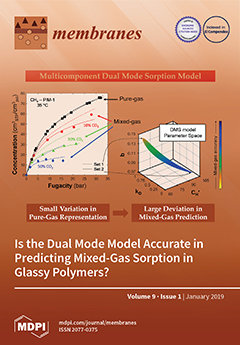Hollow fiber type cation-exchange (C-HF) membranes and hollow fiber type anion-exchange (A-HF) membranes were prepared from poly (vinyl alcohol) (PVA)-based copolymer with cation-exchange groups and by blending PVA and polycation, respectively, by a gel fiber spinning method. In order to control the water
[...] Read more.
Hollow fiber type cation-exchange (C-HF) membranes and hollow fiber type anion-exchange (A-HF) membranes were prepared from poly (vinyl alcohol) (PVA)-based copolymer with cation-exchange groups and by blending PVA and polycation, respectively, by a gel fiber spinning method. In order to control the water content of the hollow fiber membranes, the membranes were cross-linked physically by annealing, and then cross-linked chemically by using glutaraldehyde (GA) solutions at various GA concentrations. The outer diameter of C-HF and A-HF membranes were ca. 1000 μm and ca. 1500 μm, respectively, and the thickness of the membranes were ca. 170 μm and 290 μm, respectively. Permeation experiments were carried out in two Donnan dialysis systems, which included mixed 0.1 M NaCl and 0.1 M CaCl
2/C-HF /3 × 10
−4 M CaCl
2 and mixed 0.1 M NaCl and 0.1 M NaNO
3/A-HF/3 × 10
−4 M NaNO
3 to examine ionic perm selectivity of the membranes. In the Donnan dialysis experiments using C-HF membranes, uphill transport of the divalent cations occurred, and, in the case of A-HF membranes, uphill transport of NO
3− ions occurred. C-HF and A-HF membranes had about half of the flux in the uphill transported ions and also about half of the selectivity between the uphill transport ions and driven ions in comparison with those of the commercial flat sheet cation-exchange membrane (Neosepta
® CMX) and anion-exchange membrane (Neosepta
® AMX). Yet,
IEC of C-HF and A-HF membranes were about one fifth of CMX and less than half of AMX, respectively. Since hollow fiber membrane module will have higher packing density than a flat membrane stack, the hollow fiber type ion-exchange membranes (IEMs) prepared in this study will have a potential application to a Donnan dialysis process.
Full article






